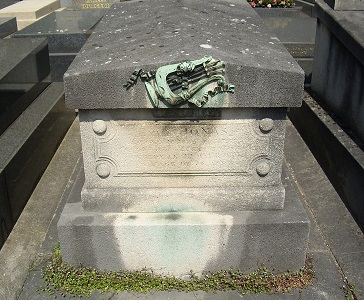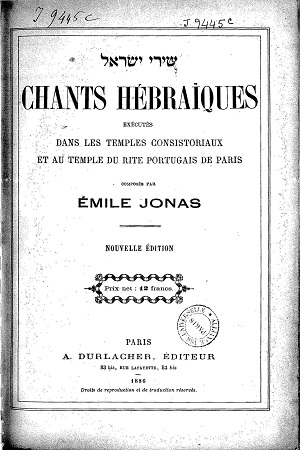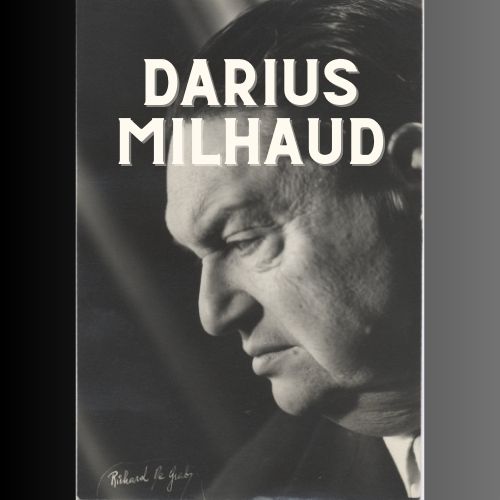
by Jacobo Kaufmann
Ever so often it happens that a composer’s fame during his lifetime, begins to slowly fade after his death and finally falls into oblivion. This also seems to be the barely justifiable case of composer Emile Jonas, who for many decades shared the Parisian theatre billboards with the most prominent French and foreign musicians during the second half of the 19th century.
At present, even though they do not enjoy the fame of the works of Jacques Offenbach (1819-1880), the absolute and undisputed monarch of the buffo genre in his own time, the operettas of Florimond Ronger (Hervé) (1825-1892), Léo Delibes (1836-1891), and in a lesser degree those of Aristide Hignard (1822-1898) or Isidore Legouix (1834-1916), as well as some of the following generation, like Edmond Audran (1842-1901), André Messager (1853-1929), Charles Lecocq (1832-1918), Louis Varney (1844-1908), Robert Planquette (1848-1903) and Claude Terrasse (1867-1923) are still remembered and sometimes performed. Less frequent are the scenic productions of Emile Jonas’ operas. There are no audio or DVD recordings. But, as we shall see, his musical output deserves at least as much.
Emile Jonas was born into a Jewish family in Paris on March 5, 1827. About his childhood, his parents Simon Jonas and Jeannette Pohl, and his private life we know very little. But we do know that in 1841, at only 14 years of age, the young Emile entered the Conservatoire National Supérieur de Musique and was admitted to the piano and harmony classes of Félix le Coupey (1811-1887) and to the composition classes of Michel Carafa (1787-1872).
In 1847 he won the Conservatory’s first harmony prize, and was named elementary solfeggio assistant professor. In 1849 he received the Institut de France’s prestigious Second Grand Prix de Rome for the composition of his Antonio cantata. He completed his studies at the CNSM in 1850, and in the following year he sent a letter to the Consistoire de Paris, offering his honorary services as an organist at the main synagogue, for which he was accepted after consultations with Fromental Halévy (1799-1862), the much hailed composer of La Juive. At the time the central Paris synagogue, the same for which several years earlier Isaac Offenbach (1779-1850) had auditioned as a chazan (cantor) and where his sons Jacques and Jules had directed the choir, was located on the site of today’s Sephardic temple on Rue Notre-Dame de Nazareth.
In 1855 Offenbach transformed the Comte theatre on Passage Choiseul into a venue designed as a miniature of the Théâtre des Italiens, at that time the Paris opera house, and it became the home of his legendary Bouffes Parisiens, offering music theatre plays with the participation of four singers at the most in each scene. With this privilege the Ministry of Culture “wishes to reward the intelligent efforts of its young director, not only because the Bouffes are the theatre of a talented musician, but also because it has become a veritable greenhouse for promising new artists”. It is in this theatre where already in October of that same year Offenbach’s theatre welcomed Emile Jonas, presenting his opera prima, the one act musical sketch Le Duel de Benjamin, much praised by J. Lovy in the Le Ménéstrel magazine.
Ever since the name of Emile Jonas was always linked to those of this theatre and his mentor, and they became sincere friends. In the following years Offenbach introduced him to the best librettists of his time and produced another six of his works, the one act buffo operas La Parade (1856), Le Roi boît (1857), Les Petits Prodiges (1857) for which Offenbach contributed at least two numbers, Job et son chien (1863), Le manoir des Larénardière (1864), Avant la noce (1865), and Désiré, sire de Champigny (1869). These works became standard repertoire of his theatre and travelled with the company of the Bouffes Parisiens on its many tours in France and other European countries. Jonas´ larger works were presented in other theatres.
During all that time Emile Jonas did not neglect his teaching activities. In 1857 he became the CNSM´s permanent harmony and composition professor for military students. Soon after he was called to become the Imperial Guard´s music director, where he developed a very intense activity, composing numerous marches, fanfares and other works for military purposes, with preference utilizing the variegated gamut of instruments invented by Adolphe Sax (1814-1894), among them an ameliorated version of the bass clarinet, the saxhorn, the saxo-trombe and his most famous patent, the saxophone.
In 1867 he was elected into the organizing committee of military parades for the unforgettable World Fair inaugurated by Napoleon III and his wife, the empress Eugenia de Montijo. Hortense Schneider visited the fair using the title of the main character in La Grande Duchesse de Gérolstein, Offenbach’s most recent triumph. Jonas was unanimously praised not only for his artistic contributions, but also for his devotion and organizational skills. He became a member of various juries, created the rules for the different competitions, and organized the fair’s music festival, in which, among works by Méhul, Auber, Gluck, Mendelssohn, Wagner, Rossini and Meyerbeer, stand out two of his own feather: La Victoire and Le Diamant. That same year he became a Chevalier and Officer of the Légion d´Honneur.
Emile Jonas has undoubtedly obtained recognition and his name has gained in prestige. Admitted in 1856 he became a part of no fewer than seven boards of directors of the French Authors and Composers Society until almost the end of that century, together with personalities such as Gounod, Labiche, Sardou and Alexandre Dumas fils. On a lithography depicting the caricatures of all important composers of its day, his image is seen in the front row, near to Offenbach’s.
Like him, Emile Jonas worked constantly. Since 1854 he was the musical and choir director of the Portuguese Rite Synagogue, the one which posing a challenge to the Consistoire’s authority had been inaugurated in 1851 on 23, rue Lamartine. Its members, in their majority stemming from the Bordeaux and Bayonne communities had brought to Paris the customs and tunes which their ancestors, descendants of the anusim (crypto Jews) from Spain and Portugal had been following since the Middle Ages at their synagogues’ religious services.
Identifying with them and preoccupied with conservation of their musical patrimony, Jonas published in 1854 a book under the title Recueil de Chants Hébraïques à l’usage des Temples de Rite Portugais (Anthology of Hebrew Chants used at the Temples of Portuguese Rite), which among a total of 39 themes lists 24 liturgical works of his own, composed mainly for soloists and diverse choral ensembles, accompanied by organ and harp.
In his capacity as musical director Jonas contributed decisively to the orderly and dignified realization of the community’s religious services, until then affected by the vicissitudes which the generations of their ancestors had had to endure, and the deterioration of their melodies after centuries of interpretative flaws. Similar are the efforts already made by highly respected composers and chazanim such as Halévy, Naumbourg, Lovy, Sulzer and Lewandowski, in order to recover, collect and use the liturgical music of the synagogues of German origin, but this is a subject that shall be dealt with on another occasion.
In 1886 Jonas published an augmented version of the previous anthology, under the title Recueil de Chants Hébraïques anciens et modernes executés au temple de rite Portugais, réunis et composés par Emile Jonas, with the addition of singing exercises, main interpretation recommendations as well as chromatic and intonation exercises. Simultaneously he documented in various publications the melodies used at the other Consistoire temples in Paris, which are in their majority of ashkenaz rite. On September 9th, 1874, during the inauguration of the Temple Consistorial Israélite de Paris (the synagogue on Rue de la Victoire) a musical piece for baritone and choir was performed on King David´s Psalm 130, which Jonas had specially composed for the occasion.
That same year he hurried to publish a volume with 21 compositions by various authors, used at that synagogue´s wedding ceremonies, and in 1879 he published another 111-page volume with the religious services music on Shabbat and all holidays, together with vocalization exercises, general recommendations for a good execution and the principal measures to be taken in order to maintain order in the temple.
During the Second Empire Paris had become an industrial, cultural and tourist centre in constant turmoil. To this city flew Europe´s and the world´s most famous artists and heads of state, together with their respective courts. There was an abundance of businessmen, nouveaux riches and adventurers. They all wanted to be entertained. The industry of show business was at its peak. Demand was huge. Artists did their very best, and so did Emile Jonas.

In 1871, after the fatal war with Prussia, came the siege of Paris, hunger, and the Commune disorders. Theatres remained temporarily closed. When they reopened the audience arrived somewhat hesitantly. The former gaiety had calmed down. That year Emile Jonas presented in London his opera Javotte (Cinderella the Younger), which in the opinion of many occupies a distinguished place among the musical works based on the Cinderella tale. In the years 1873 and 1874 he tried his fortune in Vienna, where he had two of his operas performed: Goldchignon and Die Japanesin. In 1882 he returned to the Parisian scene with still another buffo opera in three acts: La bonne aventure, based on a libretto by Hector Crémieux, produced at the Théâtre de la Renaissance. In 1883 Le premier baiser was played at the Théâtre des Nouveautés. Several years later he published in the Magazin des Demoiselles two works not yet produced: La princesse Kelebella and Miss Robinson. He has been considered the author of two more: Estelle et Némourin and Le Roi Midas, the latter performed only privately.

he piano vocal scores of almost all of the mentioned works exist at some libraries and archives in various countries, plus several librettos scattered throughout the most unbelievable places. But it has been a difficult task to establish the whereabouts of the orchestra scores. Most of the publishing houses to which these works were entrusted do not exist anymore, and those which acquired their material are not too well informed about their own possessions. One can only hope that these companies, eventual private collectors or perhaps remaining descendants of the family may suddenly appear, make a little effort, wipe off the dust on their bookshelves and discover them. After an intense, often frustrating and in most cases fruitless search, this author has been able to find and obtain the complete material for Le Canard à Trois Becs, an undoubtful praiseworthy and much entertaining work. To revive it will certainly prove to be a challenge.
These days, when it has become fashionable to resurrect forgotten music, the buffo operas of Emile Jonas have not yet been rescued from oblivion. So far we know of the existence of only a few internationally produced recordings of pieces written for saxophones and other brass instruments, whereas some of his liturgical output has been recorded thanks to the efforts of private Jewish institutions and distributed in limited numbers. In the absence of complete orchestra scores one could at least record a selection from his stage works and most certainly his songs and chamber music, with the accompaniment of a piano.
Emile Jonas does not deserve to be forgotten.






